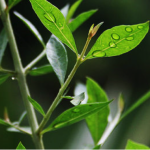Henna is the Persian name for a shrub known as Lawsonia Inermis. Henna is native to Asia, Middle East, and the surrounding areas where the climate is hot and dry. The bush now thrives in warmer climates all over the world. Its leaves produce a red dye. Twice a year the leaves are harvested, dried, and ground into a fine powder. This powder is used for many things such as hair treatment, heat rash relief, and skin conditioner to name a few. The top leaves of the plant are best for the ancient eastern art of mehndi/henna. Henna paste is what is made to apply henna art designs. The henna paste is created by mixing this fine powder with other natural ingredients such as lemon juice, sugar, essential oils, teas, etc. and is applied through a hand-rolled cone to create intricate traditional or contemporary designs on the skin. After the henna is dried and removed, it leaves behind exotic patterns for a few days to enjoy, all natural!
Lawsone is orange reddish to brownish red pigment contained in the Lawsonia Inermis. This orange reddish or maroonish brown color is the natural stain of Henna, never black. The Henna stain differs from person to person depending on the warmth of their body. Warmer the body temperature, darker the stain. Also the color stains the darkest on the thickest part of our body, i.e. the palm and the sole of our feet. Traditionally Henna is done on hands and feet, but the modern times have changed it all. Now Henna is applied on all visible parts of the body including the neck, back of the neck, shoulders, shoulder blade, forearm, forehead, belly, ankle and lower back. Different cultures have different means for Henna, but all do it to adorn the body.
Henna has religious, cultural and traditional significance for many different regions and people. While Arabic henna designs are usually large, floral patterns on the hands, Indian mehndi involves fine, thin lines for lacy, floral and paisley patterns covering entire hand and also forearms. Most traditional henna patterns are based on very simple shapes which can be combined to create a very intricate pattern and a very beautiful henna design. Varying designs have different meanings for members of each culture, such as good health, love fertility, wisdom, protection and spiritual enlightenment. Many others just apply henna at any time and occasion for the beauty of it and just because it’s fun and relaxing!
Remember, henna is NEVER black in color. If someone claims to have ‘black henna’ then know that they have dangerous chemicals in their mix which may stain the skin for a couple of days but comes off in a very flaky, discolored, and not-so-pretty way and can be very dangerous to the skin. This type of false ‘henna’ can actually burn the skin and one may get a severe allergic reaction from it. For more info. on this please visit:
http://www.hennapage.com/henna/ppd/printout.html
A true henna artist will ALWAYS stay away from using such mixes especially when they make their own very safe, authentic mix that gives a beautiful aroma and leaves behind a natural reddish/maroonish brown stain. This pretty stain will stay for 1-2 weeks and the color fades very gracefully after 7-10 days and remains on the skin for up to 3 weeks.
If you must get a black temporary tattoo, please look into safe alternatives such as ‘Harquus’ or ‘Temptu’ instead of henna.
How to Maintain Your New Henna-do?
Once you have removed the dry henna paste after 4-6 hrs or more, We recommend rubbing/scraping it off with the help of olive/ baby oil and not washing, you will see a pumpkin orange stain left on your skin. The stain will deepen into a richer reddish-brown tone over the next 48 hours.
These simple steps will protect your design and help it to look its best:
- Heat and humidity helps darken your stain while the paste is on.
- Avoid contact with water as much as possible during the first 24 hrs after paste removal as water can interrupt the oxidization and darkening processes of your henna stain. If you need to wash the paste off your skin try using a bit of lemon juice or olive/corn oil to remove any residue.
- Avoid excess rubbing of the area. Keep in mind that frequent washing, soaps, petroleum products (sunscreen, Vaseline, baby oil) and the rubbing of clothing and shoes on the design will cause your henna design to fade more quickly.
- Avoid shaving over your henna/mehndi stain. Shaving removes layers of skin so you may want to shave around your mehndi or henna stain to keep it looking its best.
How to Remove the Henna Stain
Henna stains last on average 7-10 days, gradually fading completely away. Some areas with thick or calloused skin may show portions of the stain for up to 2-6 weeks. The pretty design will last you for up to 7 days before it begins to wear off!
There are things you can do to speed along the demise of a 7+ henna stain:
- soaking in the shower, bath, pool or jacuzzi
- scrubbing or exfoliating the skin.
- chlorine can help to remove the stain as well so a dip in the pool might help
- whitening tooth paste scrubbed over the stain may help as well
Some Natural Benefits of Henna
- Natural Henna is used as hair dye, giving a very beautiful natural reddish color to the hair without drying the hair out while adding strength and texture to hair.
- Added to shampoos, conditioners and tonics and many other cosmetics for its beautifying and anti-bacterial and anti-fungal properties.
- Henna is proven to make the hair thick and shiny.
- It is also helpful against head lice.
- The Hennotannic acid in it is also useful in the reduction of dandruff.
- Henna also has a cooling and soothing affect. Perfect for applying to skin on very hot days for that cooling effect.
- It is also known to heal wounds with its anti-inflammatory and anti-viral properties.
- Henna is also proven to be a natural sun screen.
Seema is a well-known talented Henna/ Mehndi Artist in Calgary. Born in Calgary and spent most of her life in the West. She did her Bachelors from the University of Houston in Business and moved back to Calgary where she lives with her loving husband and four wonderful kids.
Seema’s journey to becoming a henna artist was rather simple! She always doodled and practiced different forms of art as her hobby. Her exposure to the cultural essence of henna/mehndi since childhood always kept her interested in this art form. When the store-bought unnatural henna products disappointed her, she almost gave up on using henna for herself. Knowing that henna art goes back a long way, she began her research to learn more and more about authentic henna. It didn’t take too long for her to discover the sweet reality of natural henna and its benefits. Her artistic and creative nature was revived! She worked hard and learned how to make her own henna paste and practiced henna art with a new state of mind. Inspired, fascinated, and eager to learn more, she began her henna journey. Over the past few years, Seema has refined her skills as she self-taught the professional techniques required to be a recognized Henna/ Mehndi Artist.
Seema’s expertise are not only limited to bridal style henna; she can create just about any traditional or contemporary design with henna whether it is Indian, Arabic, Moroccan, floral, or Celtic. Her henna art is easily adaptable to suit her client’s needs and sense of style. Through henna art, Seema strives to offer her client an experience of beautification and a sense of Joy!
Her charismatic and genuine personality is sure to make that henna experience memorable! Seema offers a variety of designs to take inspiration from and with her free-hand henna designs, creativity has no ends!

